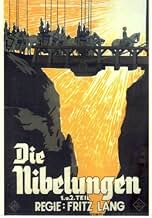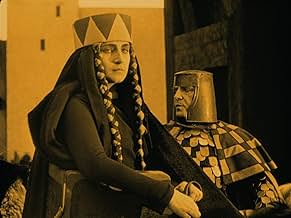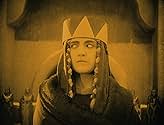IMDb-BEWERTUNG
7,9/10
5379
IHRE BEWERTUNG
Füge eine Handlung in deiner Sprache hinzuPrincess Kriemhild vows to avenge her husband's murder but must overcome her brothers who swore allegiance to Hagen. She marries Etzel, King of the Huns, and persuades his army to attack Hag... Alles lesenPrincess Kriemhild vows to avenge her husband's murder but must overcome her brothers who swore allegiance to Hagen. She marries Etzel, King of the Huns, and persuades his army to attack Hagen, but she loses more than she bargained for.Princess Kriemhild vows to avenge her husband's murder but must overcome her brothers who swore allegiance to Hagen. She marries Etzel, King of the Huns, and persuades his army to attack Hagen, but she loses more than she bargained for.
- Auszeichnungen
- 1 Nominierung insgesamt
Yuri Yurovsky
- The Priest
- (as Georg Jurowski)
Empfohlene Bewertungen
Like the first movie, The Nibelungs: Siegfried, the second part named Kriemhild's Revenge is a fantastic and epic piece with fantastic settings, imagination and acting. I really like from time to time to drown myself in those old movies, that are most imaginative and an art form and nothing less, and in comparison, most of today's movies are exposed for what they are, products of a soulless and unimaginative mass industry that does not attract genius and talent but mediocrity.
10manuelu
This film portrays revenge on an operatic scale. But do not confuse with Wagner's opera Das Ring des Nibelungen. Although both the film and Wagner's opera are based on related Norse and Icelandic sagas, Wagner devotes attention to Brünnhilde's reaction to the death of Siegfried rather than on Siegfried's widow Gutrune's (i.e. Kriemhilde's) reaction to the murder of the hero. Both the film and the opera are romantic in style. But unlike the 19th century opera, the film has elements of early 20th-century German expressionism. Everything about this film is perfect. The acting is over the top, as it needs to be. The sets are sublime. The crowd scenes are powerful. Imagine a film where the heroine makes Attlla the Hun (Etzel) seem like a reasonable, sympathetic host.
Impressive sets, costumes, and action highlight this 2 hour conclusion. The surprisingly good restoration was available for both parts on Netflix.
In some ways I suspect intentional and not, the movie subtext lays out the cultural flaws of the German/Austrian people following World War 1. The Burgundian oath upheld despite treachery and infanticide to the point of self destruction. An overwhelming need for revenge with no compromise or limit to the cost of obtaining it.
I imagine Fritz Lang and his co-writer wife sought to emphasize these faults following the war, which leads to the mutual destruction of the entire lot of Burgundy characters. Curiously the result ennobles both sides.
The non Germanic characters are grubby, disfigured, inferior animals. Only the extremes of pride, honor and infighting seem to hold the Germanic kingdom back. Within this subtext, one might see omens for the world that would be realized less than 15 years later.
The resulting film shares the same fault of its characters. Excessive pride, honor and nationalism despite the destruction and failure it had wrought. It is a vast epic and well made. But more importantly, a view of the cultural undercurrents that undermined the treaties from the war to end all wars.
In some ways I suspect intentional and not, the movie subtext lays out the cultural flaws of the German/Austrian people following World War 1. The Burgundian oath upheld despite treachery and infanticide to the point of self destruction. An overwhelming need for revenge with no compromise or limit to the cost of obtaining it.
I imagine Fritz Lang and his co-writer wife sought to emphasize these faults following the war, which leads to the mutual destruction of the entire lot of Burgundy characters. Curiously the result ennobles both sides.
The non Germanic characters are grubby, disfigured, inferior animals. Only the extremes of pride, honor and infighting seem to hold the Germanic kingdom back. Within this subtext, one might see omens for the world that would be realized less than 15 years later.
The resulting film shares the same fault of its characters. Excessive pride, honor and nationalism despite the destruction and failure it had wrought. It is a vast epic and well made. But more importantly, a view of the cultural undercurrents that undermined the treaties from the war to end all wars.
Like grand opera, this film and its predecessor, "Siegfried", are a little too slow in pace, but the visual treats are unforgettable. It is best to see the two films together, but the sequel is not as good, mainly because there is not very much story left. Most of the time it's just Kriemhild wandering around looking vengeful, but Margarethe Schoen does it so well! The performance of Rudolph Klein-Rogge as Attila the Hun is wildly energetic - he is magnificent. But you can't help thinking why don't they just kill Hagen Tronje and get on with life, especially after he murders the baby. Something to do with Teutonic loyalty apparently.
But who can forget the rabbit-warren Hun village, and all those grubby Huns running about. Of course the film is racist as the Teutons somehow survive against overwhelming numbers of Huns - no wonder Hitler liked this film. "Siegfried" was very fascist too, with the glorious Aryan impregnable and very gorgeous (thanks to Paul Richter). But "Kriemhild's Revenge" lacks the wonderful fantasy sequences of "Siegfried" like the dwarves kingdom and especially that superb dragon fight - but at least here Kriemhild herself gets some balls - she seemed so stupid in "Siegfried".
But who can forget the rabbit-warren Hun village, and all those grubby Huns running about. Of course the film is racist as the Teutons somehow survive against overwhelming numbers of Huns - no wonder Hitler liked this film. "Siegfried" was very fascist too, with the glorious Aryan impregnable and very gorgeous (thanks to Paul Richter). But "Kriemhild's Revenge" lacks the wonderful fantasy sequences of "Siegfried" like the dwarves kingdom and especially that superb dragon fight - but at least here Kriemhild herself gets some balls - she seemed so stupid in "Siegfried".
"Die Nibelungen: Kriemhild's Revenge" is part of the two-part, five hour long saga from Fritz Lang. The first part, "Die Nibelungen: Siegfried" follows the Germanic hero from various heroic deeds (such as slaying a dragon) to his eventual murder.
When part two begins, his widow, Kriemhild is naturally furious. After all, her husband was murdered and no one has been punished. To make it worse, her family has sworn allegiance to the murderer! The movie consists of her machinations to bring the killer to justice, though through this there are wars, lots of death and an ending where practically everyone expires!
What I didn't love were the English captions added to the film. They were is a VERY stylized Germanic font...and were VERY difficult to read. I also was not fond of an overuse of staring and folks standing at attention instead of ACTING (a problem also in Sergei Eisenstein's "Ivan the Terrible" saga). It also should be noted that in this English version, King Etzel is translated as King Attila (as in, Attila the Hun).
What were exceptional were the costumes, the sets (some of which were pretty simple but others really were amazing) and the wonderful print (it was pristine) I found of it on YouTube.
When part two begins, his widow, Kriemhild is naturally furious. After all, her husband was murdered and no one has been punished. To make it worse, her family has sworn allegiance to the murderer! The movie consists of her machinations to bring the killer to justice, though through this there are wars, lots of death and an ending where practically everyone expires!
What I didn't love were the English captions added to the film. They were is a VERY stylized Germanic font...and were VERY difficult to read. I also was not fond of an overuse of staring and folks standing at attention instead of ACTING (a problem also in Sergei Eisenstein's "Ivan the Terrible" saga). It also should be noted that in this English version, King Etzel is translated as King Attila (as in, Attila the Hun).
What were exceptional were the costumes, the sets (some of which were pretty simple but others really were amazing) and the wonderful print (it was pristine) I found of it on YouTube.
Wusstest du schon
- WissenswertesAttila's castle was built life-size. The fire was started by Fritz Lang himself by shooting an arrow, tipped with burning magnesium, onto the roof.
- PatzerAt 19:38, as you see the treasure in the water, you can see a hand in the reflection to the left of the sword. Presumably it was filmed in a fish tank.
- Alternative VersionenA 2012 restoration project completed by the Friedrich-Wilhelm-Murnau-Stiftung has been released by Kino Lorber on both DVD and Blu-ray formats. Both "Die Nibelungen: Siegfried" (1924) and "Die Nibelungen: Kriemhild's Revenge" (1925) are included. The film's running times differ from other versions at 149 minutes and 131 minutes, respectively. This can be attributed to the fact that the restoration utilized some footage from different takes of scenes and slight adjustments were made to the 'frames-per-second' rate perhaps to present a more realistic flow of the action.
- VerbindungenEdited into Fritz Lang, le cercle du destin - Les films allemands (2001)
Top-Auswahl
Melde dich zum Bewerten an und greife auf die Watchlist für personalisierte Empfehlungen zu.
- How long is Die Nibelungen: Kriemhild's Revenge?Powered by Alexa
Details
- Erscheinungsdatum
- Herkunftsland
- Sprache
- Auch bekannt als
- Kriemhilds Rache - Der 2. Nibelungenfilm
- Drehorte
- Produktionsfirmen
- Weitere beteiligte Unternehmen bei IMDbPro anzeigen
- Laufzeit
- 1 Std. 37 Min.(97 min)
- Sound-Mix
- Seitenverhältnis
- 1.33 : 1
Zu dieser Seite beitragen
Bearbeitung vorschlagen oder fehlenden Inhalt hinzufügen






























